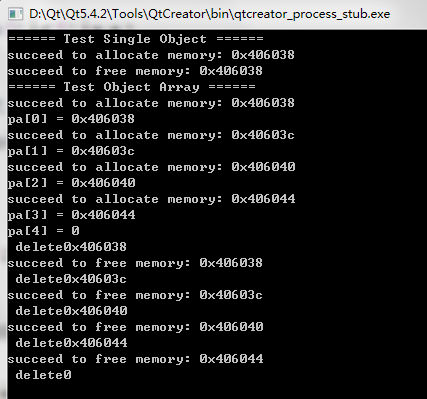#include <iostream>
#include <string>
using namespace std;
class Test
{
private:
static const unsigned int COUNT = 4;
static char c_buffer[]; //首先定义一个静态存储区
static char c_map[];
int m_value;
public:
void* operator new(unsigned int size)
{
void* ret = NULL;
//利用for循环查找在c_buffer这片空间中哪些是空闲的,可以用于创建一个Test对象。
//遍历COUNT个位置,看每个位置有没有对象存在,如果没有对象存在,那么就可以返回这片内存空间。并且在这片内存空间中调用构造函数创建对象。
for(int i=0; i<COUNT; i++)
{
if(!c_map[i])
{
//表示当前的内存空间是可以用的
c_map[i] = 1;
ret = c_buffer + i * sizeof(Test);//做一个指针运算,用来查找c_buffer这块区域的可用空间的首地址
cout << "succeed to allocate memory: " << ret << endl;
break;
}
}
return ret;
}
void operator delete(void* p)
{
if( p != NULL)
{
char* mem = reinterpret_cast<char*>(p);
int index = (mem-c_buffer) / sizeof(Test);
int flag = (mem-c_buffer) % sizeof(Test);
if((flag == 0) && (0 <= index) && (index < COUNT))
{
c_map[index] = 0;
cout << "succeed to free memory: " << p <<endl;
}
}
}
};
//既然是静态的数组,需要在类外分配空间
char Test::c_buffer[sizeof(Test) * Test::COUNT] = {0}; //定义一块静态的内存空间,这块内存空间中想要存储的就是Test对象,最多就可以存储4个Test对象。
char Test::c_map[COUNT] = {0}; //用来标记在哪些位置已经创建了对象。
int main()
{
cout << "====== Test Single Object ======" << endl;
Test* pt = new Test;
delete pt;
cout << "====== Test Object Array ======" << endl;
Test* pa[5] = {0};
for(int i=0; i<5; i++)
{
pa[i] = new Test;
cout << "pa[" << i << "] = " << pa[i] << endl;
}
for(int i=0; i<5; i++)
{
cout << " delete" << pa[i] << endl;
delete pa[i];
}
return 0;
}

这个例子的精妙之处就是控制对象的产生的数目,就像该例中,只能产生4个对象。